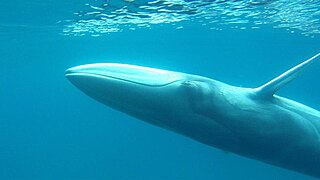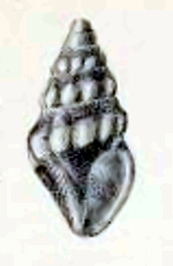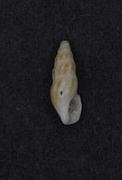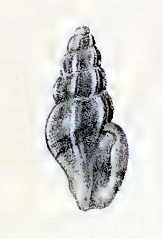
Hector's beaked whale, is a small mesoplodont living in the Southern Hemisphere. This whale is named after Sir James Hector, a founder of the colonial museum in Wellington, New Zealand. The species has rarely been seen in the wild.

The tropical bottlenose whale, also known as the Indo-Pacific beaked whale or Longman's beaked whale, was considered to be the world's rarest cetacean until recently, but the spade-toothed whale now holds that position. As of 2010, the species is now known from nearly a dozen strandings and over 65 sightings. This is the only species in the genus Indopacetus.

Omura's whale or the dwarf fin whale is a species of rorqual about which very little is known. Before its formal description, it was referred to as a small, dwarf or pygmy form of Bryde's whale by various sources. The common name and specific epithet commemorate Japanese cetologist Hideo Omura.

Bigfin squids are a group of rarely seen cephalopods with a distinctive morphology. They are placed in the genus Magnapinna and family Magnapinnidae. Although the family was described only from larval, paralarval, and juvenile specimens, numerous video observations of much larger squid with similar morphology are assumed to be adult specimens of the same family.

The Cape lobster, Homarinus capensis, is a species of small lobster that lives off the coast of South Africa, from Dassen Island to Haga Haga. Only a few dozen specimens are known, mostly regurgitated by reef-dwelling fish. It lives in rocky reefs, and is thought to lay large eggs that have a short larval phase, or that hatch directly as a juvenile. The species grows to a total length of 10 cm (3.9 in), and resembles a small European or American lobster; it was previously included in the same genus, Homarus, although it is not very closely related to those species, and is now considered to form a separate, monotypic genus – Homarinus. Its closest relatives are the genera Thymops and Thymopides.

Enteroctopus is an octopus genus whose members are sometimes known as giant octopuses.

Endothiodon is an extinct genus of medium to large dicynodont from the Late Permian. Like other dicynodonts, Endothiodon was an herbivore, but it typically lacked the two tusks that characterized most other dicynodonts and instead had long rows of teeth inset in the jaws that replaced in waves. The anterior portion of the upper and lower jaw are curved upward, creating a distinct beak that is thought to have allowed them to be specialized grazers.

The colossal squid is the world’s largest squid species and the world’s largest mollusc. It belongs to the Cranchiidae family, that of the cockatoo squids or glass squids. It is sometimes called the Antarctic cranch squid or giant squid and is believed to be the largest squid species in terms of mass. It is the only recognized member of the genus Mesonychoteuthis and is known from only a small number of specimens. The species is confirmed to reach a mass of at least 495 kilograms (1,091 lb), though the largest specimens—known only from beaks found in sperm whale stomachs—may perhaps weigh as much as 600–700 kilograms (1,300–1,500 lb), making it the largest known invertebrate. Maximum total length has been estimated between 10 metres (33 ft) and 14 metres (46 ft) but the former estimate is more likely. The colossal squid has the largest eyes of any known creature ever to exist, with an estimated diameter of 27–30 cm (11–12 in) to 40 cm (16 in) for the largest collected specimen.

Lumkuia is an extinct genus of cynodont, fossils of which have been found in the Cynognathus Assemblage Zone of the Beaufort Group in the South African Karoo Basin that date back to the early Middle Triassic. It contains a single species, Lumkuia fuzzi, which was named in 2001 on the basis of the holotype specimen BP/1/2669, which can now be found at the Bernard Price Institute in Johannesburg, South Africa. The genus has been placed in its own family, Lumkuiidae. Lumkuia is not as common as other cynodonts from the same locality such as Diademodon and Trirachodon.

Psittacodrillia albonodulosa is a species of sea snail, a marine gastropod mollusk in the family Horaiclavidae.

Psittacodrillia bairstowi is a species of sea snail, a marine gastropod mollusk in the family Horaiclavidae.

Clavus hottentotus is a species of sea snail, a marine gastropod mollusk in the family Drilliidae.

Hastula apicitincta is a species of sea snail, a marine gastropod mollusc in the family Terebridae, the auger snails.

Myurellopsis kilburni is a species of sea snail, a marine gastropod mollusc in the family Terebridae, the auger snails.
Poropteron uncinarius is a species of sea snail, a marine gastropod mollusc in the family Muricidae, the murex snails or rock snails.

Vaughtia scrobiculata is a species of sea snail, a marine gastropod mollusc in the family Muricidae, the murex snails or rock snails.
Hypselodoris rudmani is a species of sea slug or dorid nudibranch, a marine gastropod mollusk in the family Chromodorididae. This species is named after the well known malacologist William B. Rudman.

The southern bottlenose whale is a species of whale, in the ziphiid family, one of two members of the genus Hyperoodon. Seldom observed, the southern bottlenose whale is resident in Antarctic waters. The species was first described by English zoologist William Henry Flower in 1882, based on a water-worn skull from Lewis Island, in the Dampier Archipelago, Western Australia. They live in deep ocean waters over 1000 meters.

Megapnosaurus is an extinct genus of coelophysid theropod dinosaur that lived approximately 188 million years ago during the early part of the Jurassic Period in what is now Africa. The species was a small to medium-sized, lightly built, ground-dwelling, bipedal carnivore, that could grow up to 2.2 m (7.2 ft) long and weigh up to 13 kg (29 lb).

Pseudorhaphitoma alfredi is a small sea snail, a marine gastropod mollusk in the family Mangeliidae.

















